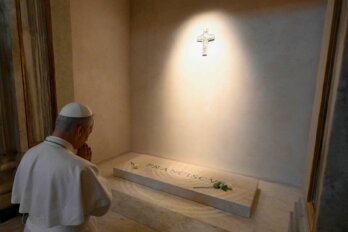“In the Romantic period, we were painted out of the narratives, and in Modernism it was further ensured that aboriginal narratives wouldn’t enter the canon, by deconstructing painting’s ability to tell stories. Paul Kane’s work is still the untouchable voice of authority. I mean, look at those paintings, the buckskinned Indians under thundering clouds, with rearing horses, straight out of a Jacques-Louis David painting. It’s just bizarre, right? The American painter George Catlin wanted to found this park where aboriginal people would live forever frozen in time, in classic attire, hunting buffalo and elk, where the refined of the world in future ages could come and observe them — Jurassic Park, basically.
“The reason I respond to these artists is because I think their work is important. It’s worth examining that whole period of art, so purely one-sided, like a big cover-up of what was really happening. I try to approach it with humour, focusing on the side of art culture that is about survival and being able to adapt, and to look forward. It’s a very gentle way of making people aware of this huge obliteration of our narratives. Bringing together these different ways of seeing and recording history in one painting makes you aware of how you can interpret it through the images that you create.
“Miss Chief Eagle Testickle, a character that appears in much of my work, was created as a way of challenging the subjectivity of the artist, challenging these signifiers of aboriginal identity that had become so popular in Hollywood film and nineteenth-century painting. But it was more than just the idea; the execution has to be masterful in order to carry the same authority about our perspective on these same critical events. Miss Chief is this playful way of inserting ourselves into these painted histories where we didn’t exist or were sidelined as bit players.
“Catlin writes about encountering these beautifully dressed and flamboyant men in every tribe. Drawing one beau, who didn’t have the status of chief or high-ranking warrior, created such a backlash that the artist had to stop at the chalk drawing, so it just doesn’t exist anymore. There’s something really beautiful about that, something so completely impermanent and erasable. To me, this speaks about all the other histories and narratives that were never authorized.”





